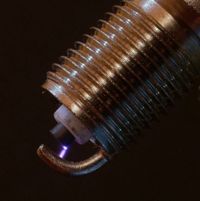
Photo from wikipedia
Abstract Hot pressing and spark plasma sintering were applied to manufacture electrical discharge machinable ZTA-TiC ceramics containing 17 vol.% zirconia (1.5Y) and 24 vol.% titanium carbide in an alumina matrix. Sintering was… Click to show full abstract
Abstract Hot pressing and spark plasma sintering were applied to manufacture electrical discharge machinable ZTA-TiC ceramics containing 17 vol.% zirconia (1.5Y) and 24 vol.% titanium carbide in an alumina matrix. Sintering was carried out at 1450–1600 °C and 40 MPa pressure with 2 h dwell for HP and 10 min for SPS. The influence of sintering conditions on mechanical properties, microstructure, phase composition and electrical conductivity was investigated. Both sintering technologies lead to fully densified samples with similar strength and toughness. Hardness was generally lower for SPS. SPS samples develop a finer microstructure. HP samples the TiC grains tend to merge at high sintering so that HP materials reach significantly higher conductivities. Productivity and energy consumption per piece can be significantly decreased by shifting to SPS. Both types of material were ED-machinable. Hot pressed ceramics showed better cutting performance and improved surface quality in trimming operations.
Journal Title: Journal of The European Ceramic Society
Year Published: 2018
Link to full text (if available)
Share on Social Media: Sign Up to like & get
recommendations!